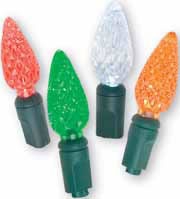 As you shop this holiday season, you’re probably seeing a lot more LED Christmas lights. Their colors are more vibrant and they’re vastly more energy efficient than conventional incandescent Christmas lights. But do they pay off?
As you shop this holiday season, you’re probably seeing a lot more LED Christmas lights. Their colors are more vibrant and they’re vastly more energy efficient than conventional incandescent Christmas lights. But do they pay off?
Let me ask you something – when you buy a string of lights for decorating, are you thinking “what is the cost-benefit ratio of these lights?” Or, are you thinking “will these look good in my house?” Me personally? I’m thinking that I hope they last for more than one season and I don’t spend next Christmas searching all day for that one burned out bulb! Few things put me in a foul mood faster during the holiday season than having to waste time. I’ve purchased a variety of LED light sets. Some are fantastic, while others are too faint. But all have been reliable and none have burned out. This alone make’s it worth the $10-$20 per string.
What about energy savings?
We all know that LEDs are more efficient than incandescent bulbs. What you probably don’t know is that the lower the power, the less efficient the incandescent bulb. So the tiny bulbs used for holiday lighting are about as inefficient as you can get. Depending on the lights, LEDs can be about 80% more efficient than conventional bulbs. Put another way, it costs you about four to five times as much to power conventional mini-lights than LEDs.
As an example, this string from EFI’s store, uses only 3.4 watts per 24-foot string of 70 bulbs. If you use mini-lights, you’re consuming about 15 watts per string. But if you’re using the larger bulbs, the savings really add up. Larger bulbs might use 1 watt or more per bulb!
This energy consumption adds up. Since many holiday lights are burning round the clock for several weeks, the total power consumed can be significant. For example, you might use three of these long strings on your tree and another five on and around the house. Let’s call it eight total.
Those eight strings, each requiring 3.4 watts, consumes 13.7 kWh if used for three weeks. That costs about $2.00 (for all eight strings). Not at all bad.
Mini-lights will cost about 5x that amount to run, or about $10.00. Still, not a big deal. You’re not going to pay off the price difference between the LEDs and the mini-incandescents any time soon. But if you use LED’s to replace larger bulbs, you’re going to save somewhere between $30-$50 per year (again on all eight strings). Now that starts adding up and you’ll pay off the LEDs in just a few years.
Note that these comparisons assume that the incandescents actually last. I find that I’m lucky to get a couple years out of a conventional string. Usually, I end up salvaging bulbs from one non-functional string to bring another back to life. Just the time wasted doing this costs more than the cost of the LED string. This is much less of a problem with larger incandescent bulbs because those typically are easier to track down. But then, in those cases, the financial equation is much more compelling.
No matter what, you’ll probably find that you purchase at least one string of LEDs in the next couple years. As prices drop and they become available at more stores, you’ll also find more disappointing strings of LED lights, so be sure to see what they look like before you invest. But definitely try them out. A good set of LED Christmas lights will literally last forever.

The only problem with LEDs is rust. The wires are copper and the leads comming off the LEDs are steal = rust. I’ve had some of my LED strings outside for 3 Christmas seasons now and some sockets are starting to show rust but they still work. The most important step to preventing rust is to make sure they are not outside for too long and when you put them away for the season that they’re dry. I bought some GE LED C9 look alikes (I call them look alikes because they look to be the same size as a C9 incandesent but all they really are is a plastic cover over a regualar sized LED) and used them for the second season. They weren’t the cheapest LEDs but they were on sale for a decent price. They also had some features that you won’t find in lower end LEDs like “constant-on” (if one bulb burns out the rest stay lit). This constant-on feature came in handy because these LEDs were designed poory, water would fill up the plastic cover and could not escape, rusting the LED right out of the socket. If the temperature got below freezing the water would expand poping the platic cover right off. Luckily only about 10 LEDs had to be replaced out of about 150. Many more of the plastic light covers came off about 1/3. GE has fixed this problem by drilling two holes in the plastic cover to let water drain out. I have the newer version and none of them have had this problem and probably arn’t nearly as rusty. I have since fixed my older GE LEDs by drilling two small holes in each cover. Here’s a link to the GE lights I’m talking about
Great observations. I didn’t put my strings outdoor this year but I’ll have to keep an eye out for those issues.